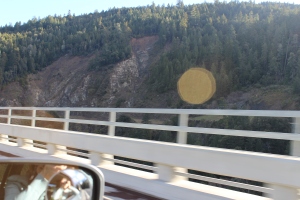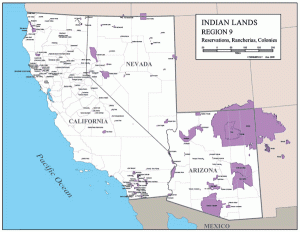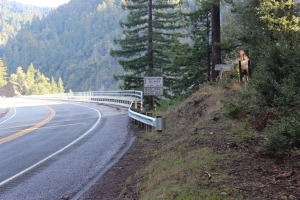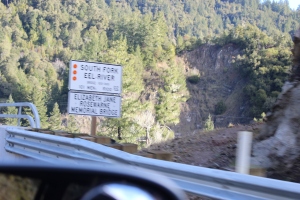As you may have noticed, I haven’t said much here lately, but this is a new year, so I’m resolving to do more. I’ve had a lot of observations about women on the landscape, but not enough resolve to write them down. I’m hoping to do better.
So, today I’m posting about things that have recently been on my mind: Northern California and highways. The two come together in the bridges over the South Fork of the Eel River on Highway 101.
CalTrans constructed these two bridges at Confusion Hill near Leggett, CA, fairly recently (2006-2008) after battling a reoccurring slide on the old highway route across the river. The slide often closed the road to traffic at least once a year (it was kind of exciting to live in a place that could get cut off from the outside world if only for a few hours or a day). Located at a bend in the river, the bridges bypass the slide by crossing and then recrossing the Eel, hundreds of feet above the water.

The old highway (now covered by debris from the slide) runs along the cliffs and is visible from the bridge; though hard to capture from a moving vehicle.
The interesting thing about these two bridges is that they were named for women, an unusual sight along most highways–seriously, look at all those memorial bridge and highway signs, women are few and far between. Trying to find out if there were many memorial signs for women I did learn that the Hutchinson Parkway of New York City was named for Elizabeth Hutchnison of Massachusetts Bay colony fame. It turns out that there was more to the story than that she left Massachusetts Bay colony and moved to Rhode Island colony. She and her family later moved again to New York, where they were killed by local native people, the Siwanoy, who were defending themselves from the colonial invasion. Hence the memorial in New York.
Likewise, the two bridges here in Northern California are named for white women who are considered pioneers in the area. On the south end is the Mignon “Minnie” Stoddard Lilley Memorial Bridge and to the north the Elizabeth Jane Rosewarne Memorial Bridge. Both women were important parts of the local community in the early twentieth century as teachers and businesswomen. Minnie Stoddard taught for over 20 years in Mendocino County. She also homesteaded the area just south of Confusion Hill where she opened the Tree House in the trunk of a living redwood. This was one of the first tourist shops built on the new Highway 101, a road for which Minnie and her husband, William Lilley, deeded land to the state for its construction. Minnie is celebrated for her grit and determination in homesteading the area and for her role in teaching and serving as the first school bus driver. Elizabeth Jane Rosewarne, homesteaded with her husband, Nicolas on the northside of the Eel River, just where the bridge touches down and where there is also a road named in her honor. There she cared for her family, raising and canning vegetables, fishing, sewing clothing, and caring for animals. She is also remembered for being a good neighbor. After her husband died in 1922 — just as the new highway was pushing through the area, she opened a store and Texaco Star gas station to support herself. The women’s connections to the highway and transportation make both women a logical choice for a memorial bridge. But much of the emphasis is also on their “pioneer” spirit. Indeed, each had their share of adventure in the sparsely populated and rugged area, rowing across the river and hiking through the forests, encountering mountain lions and squatters. The family of Elizabeth Jane Rosewarne argued that it was “fitting tribute to name both bridge spans after two pioneer women, inspiring women and young girls growing up, or traveling to and from the area, to know that pioneer women played a key role in the history of Mendocino County.”
And it is true, I’m very happy to see some women’s names while driving down the highway, and I heartily applaud the efforts of the families, local communities and state politicians for their effort to include a bit of gender diversity in the mix of the history we remember along the road.
But, the signs up and down the highway, are still pretty racially homogenous, and none of the discussions about the early pioneers points out that the land they homesteaded had once belonged to native people. And this in a place that has a large number of native people who survived and are living on small parcels their original lands despite the best efforts of many early settlers from the generation before Minnie and Elizabeth homesteaded the area. During the 1850s, Anglos committed great violence against the Yuki, Pomo, Cahto and Winton people in order to access their land and their labor. Settlers raided native communities, killing many and forcing others into slavery. The government placed the survivors onto reservations and rancherias, (including the Round Valley Reservation in 1870) opening the rest of their land to settlement for white pioneers. Even after Indian slavery was outlawed in California, native people continued to work as cheap labor, often agricultural, for white farmers.

Although hard to read, this EPA district map of tribal lands shows the numerous small rancherias in Mendocino County in Northern California. From http://www.epa.gov/region09/tribal/success/06/images/region9-tribal-lands.gif
These stories haven’t made it onto the history emblazened on highway signs yet, or at any rate their legacy hasn’t been questioned. In fact, just thirteen miles south of the bridges near Cummings, California, this legacy of racism is still visible where the highway crosses “Squaw Creek,” with its name drawn from the racially-derogatory term for native women. Such terms were used to dehumanize native people and justified their enslavement, the taking of their land, and their restriction to reservations in the nineteenth and early twentieth centuries.
So, what about the native women and girls who drive the highway today in the 21st century? What stories is it telling them?



Connecticut apparently has only one highway named for a woman: Ella Grasso Highway (Route 75). And even then, it’s only the part of the highway that goes through Windsor Locks.
2014 and we continue to do a Great Disservice to our Native Culture and the land they once Honored and cared for. It is up to each of us as individuals to do our part to remember in the mean time and perhaps our local, state and federal government agencies will eventually follow Our Lead.
Thanks, Dave. I didn’t know about Connecticut’s Ella Grasso Highway. Now I’m on the lookout for more!